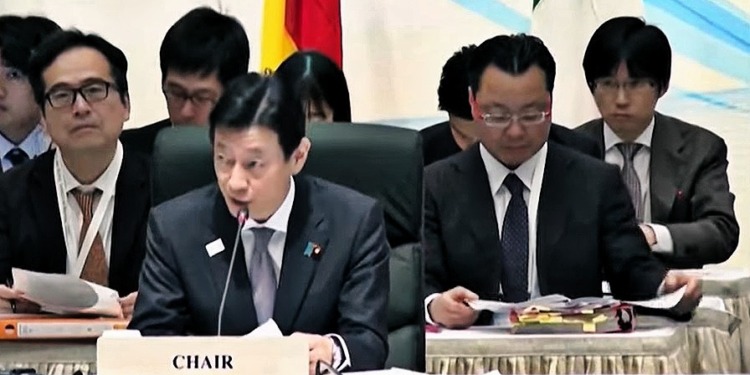When the G7 climate and environment ministers of the world’s most advanced countries came together this weekend in Japan to discuss climate and energy issues, they met under a cloud: Many climate activists accused the host country of being an “outlier among its peers”, of having chosen the wrong strategy, eschewing the transition to clean energy and instead opting to keep burning fossil fuels with the stratagem of “abating” their impact with carbon capture and storage (CCS) technology.
Banking on CCS technologies for gas and coal-fired power plants “is a very, very dangerous play by the Japanese government,” said Maria Pastukhova, a senior policy advisor at E3G, a climate change think tank. And she added, their use as climate fixes, “have not yet proven commercial and it is uncertain how scalable these solutions are, or how fast the cost can be reduced.”
Bloomberg cogently argued in a well-informed article full of data that it compiled together with the Network for Greening the Financial System (NGFS), an organization of more than 100 central banks and regulators, that Japan’s current emissions-reduction trajectory “strays the furthest from what’s needed by 2030 to reach net zero by 2050”. It noted that Japan needs to reduce a further 45% of its current emission trend to reach the NGFS carbon emission goal by 2030.
Worse, according to Climate Action Tracker, no G-7 country has made pledges to the United Nations that are sufficient to keep the world from warming less than 1.5 degrees Celsius from pre-industrial levels. More generally, the world is in a very bad place with respect to the 2030 targets:

Against this dire backdrop, the G7 communiqué rings a welcome and positive note – so positive that one might be tempted to not quite believe them.
In a nutshell, what we see are big new targets for solar power and offshore wind capacity, agreeing to speed up renewable energy development and move toward a quicker phase-out of fossil fuels.
On the negative side, they did not set 2030 as a deadline for phasing out coal that Canada and other members had pushed for and left the door open for continued investment in gas, arguing gas has a role in meeting potential energy shortfalls.
But let’s take a closer look at what they said and how they believe they can accelerate the transition to clean energy.
What’s in the G7 climate and energy communiqué: All the right-sounding moves to accelerate the green transition
The hefty 36-page communiqué starts off with a strong condemnation of Russia and its “illegal, unjustifiable, and unprovoked war of aggression against Ukraine”, noting the devastating global impact of the war and declaring themselves “ready to support the sustainable and resilient recovery and green reconstruction of Ukraine.”
Next, they renew their “steadfast commitment” to the goals of the 2015 Paris Climate Agreement; both the “historic Kunming-Montreal Global Biodiversity Framework (GBF)” to halt and reverse biodiversity loss by 2030, and “the landmark international legally binding instrument on the conservation and sustainable use of marine biological diversity of areas beyond national jurisdiction (BBNJ)” get their full support.
In short, and despite what Japan’s apparent strategy appears to be, they confirmed their “commitment to accelerating the clean energy transition to net-zero greenhouse gas (GHG) emissions by 2050 at the latest”. Likewise, full support is expressed for every major actor, including the IPCC and science contributions, and businesses are urged “to contribute to the achievement of the 2030 Agenda and its SDGs throughout their value chains”, in particular, “SMEs, through sharing best practices”; and developing countries are not forgotten: the G7 states it is committed “to supporting capacity building in developing countries” with an aim to “increase resilience to climate change and environmental degradation”.
There is something for everyone
The range of topics covered is awesome: from finance, food, and water to fishing and forests, soil degradation, and ocean governance – including the UN Decade of Ocean Science for Sustainable Development (2021-2030); from the issue of inclusion, indigenous people, gender equality and just transition, to nature-based solutions for sustainable development and species protection including addressing the issue of invasive alien species (IAS), noting that this was identified as one of the five direct drivers of global biodiversity loss in the IPBES Global Assessment Report.
Of special interest is their “30 by 30” pledge: That is the “commitment to achieving the target of effectively conserving and managing at least 30 percent of terrestrial and inland water areas, and at least 30 percent of marine and coastal areas by 2030 (30 by 30) nationally and globally”. If they are serious about such targets, then it should have a direct impact on the outcome of the ongoing debate at the International Seabed Authority (ISA) where commercial exploitation of the deep sea in the area beyond national jurisdiction (some 54% of all oceans) is currently envisaged.
With regard to finance, among many policies mentioned, noteworthy is their support for the International Sustainability Standards Board tasked with developing a global baseline for sustainability reporting standards, and the highlighting of the coming “Summit for a New Global Financing Pact” organized by France to be held in Paris in June with the aim of enhancing resilience to climate change of vulnerable countries and encourage the green transition of developing and emerging economies.
The need to fight environmental crimes is also underlined, calling for “efforts to strengthen international and transboundary cooperation” to combat wildlife trafficking, trafficking in timber and timber products, hazardous and other waste, and precious metals, gemstones and other minerals, illegal mining and logging, and illegal unreported and unregulated (IUU) fishing.
Of course, when calling for “efforts”, this is a convenient, positive term that could mean anything and nothing. In fact, this is a communiqué with plenty of good intentions and very few quantified targets.
What has drawn the most attention from climate activists and observers
The following policies specifically supported by the G7 have been singled out repeatedly in the press, notably by Reuters in a striking series of “factbox-Key excerpts”:
- investment in the gas sector: They are seen as “appropriate to help address potential market shortfalls” but should be “subject to clearly defined national circumstances” and “implemented in a manner consistent with our climate objectives and without creating lock-in effects”;
- Expansion of renewable energy is supported “globally and bringing down costs by strengthening capacity including through a collective increase in offshore wind capacity of 150 gigawatt by 2030 based on each country’s existing targets and a collective increase of solar (photovoltaic) to more than 1 terawatt by 2030.”
- Regarding coal-fired plants: The G7 is committed to “achieving a fully or predominantly decarbonised power sector by 2035” and this will be done by “accelerating the phase-out of domestic unabated coal power generation in a manner consistent with keeping a limit of 1.5°C temperature rise” – note that “unabated” in this context refers to carbon emissions that are not balanced out by an equivalent “abating” measure (usually CCS technology); aware that the use of coal is prevalent in the rest of the world (China, are you listening?), the G7 “ call on and will work with other countries to end new unabated coal-fired power generation projects globally as soon as possible to accelerate the clean energy transition in a just manner.”
- Phasing out unabated fossil fuels: They stand committed ” to accelerate the phase-out of unabated fossil fuels so as to achieve net zero in energy systems by 2050 at the latest” and “ stress that fossil fuel subsidies are inconsistent with the goals of the Paris Agreement” and that is a “biggie” if they adhere to this pledge, given the continuing high level of fossil fuel subsidies worldwide, hitting an all-time high in 2022.
- Nuclear energy remains in the game since, as the communiqué puts it, it has the “potential to provide affordable low-carbon energy that can reduce dependence on fossil fuels”, but these countries are urged to “also commit to support the development and construction of nuclear reactors, such as small modular and other advanced reactors with advanced safety systems”, in line with the International Atomic Energy Agency safety standards.
- Support for “low-carbon and renewable hydrogen and its derivatives such as ammonia” to be developed, “notably in hard-to-abate sectors in industry and transportation”; they also “note” that “some countries” are exploring “the use of low-carbon and renewable hydrogen and its derivatives in the power sector”;
- Critical minerals: Here their importance in the clean energy transition is “reaffirmed” and the G7 declares itself “fully committed to maintain products containing critical minerals and raw materials in the economy as long as possible” while emphasising “ the importance of countering geopolitical risks, including with respect to critical minerals, for the clean energy transition” and while supporting the development of “new mines and supply chains for critical minerals”, it should be done “in a responsible manner that promotes transparency and traceability to meet the rising demand” and it notes that “Currently $13 billion fiscal support that can be used for domestic and foreign projects is prepared across the G7 countries.” – again ISA should take note of this requirement for “responsible” development of new mines when (and if) it decides to issue deep-mining exploitation permits: But that is an issue set to come to a head when the ISA Council next meets in July to finally decide whether to pause deep-sea mining or not.
- End plastic pollution: Along with this pledge they also state they have “the ambition to reduce additional plastic pollution to zero by 2040.”
- A highly decarbonised road sector by 2030 is a G7 commitment: note that this leaves open the extent of decarbonisation: what does “highly” mean in this context?
The language here, as elsewhere in the communiqué, is the diplomatico-UN-ese type of language we have all come to expect from our ministers when they are thrown on the global stage. But perhaps the following statement regarding global transportation – and recognizing China, India and other countries’ ambitions in this sector – is a diplomatic masterpiece of sorts:
“We recognise the range of pathways that G7- and beyond-G7 members are adopting to approach this goal. We are committed to the goal of achieving net-zero emissions in the road sector by 2050, and underline that a transition over the coming decade to infrastructure and a vehicle fleet that supports zero emissions transport is critical.”
Indeed, there is little doubt that in our fight against climate change, our biggest hurdle is the “range of pathways” that countries are “adopting to approach” the goal – yes, not to reach the goal, and that is precisely the problem.
Editor’s Note: The opinions expressed here by Impakter.com columnists are their own, not those of Impakter.com. — In the Featured Photo: Akihiro Nishimura, Environment Minister of Japan delivers his speech at the G7 meeting in Sapporo, Japan, April 16, 2023 Source: screenshot WION video










